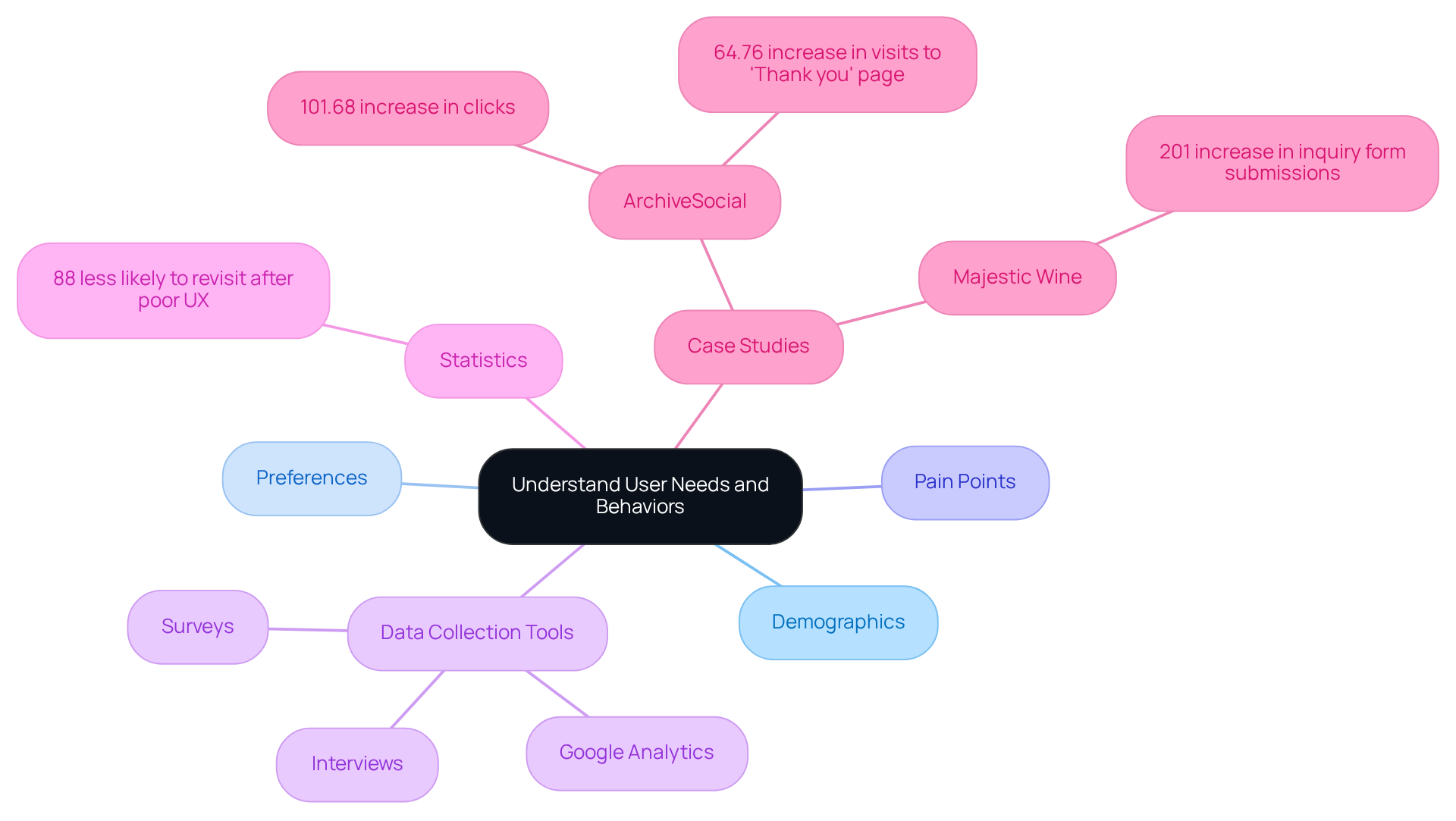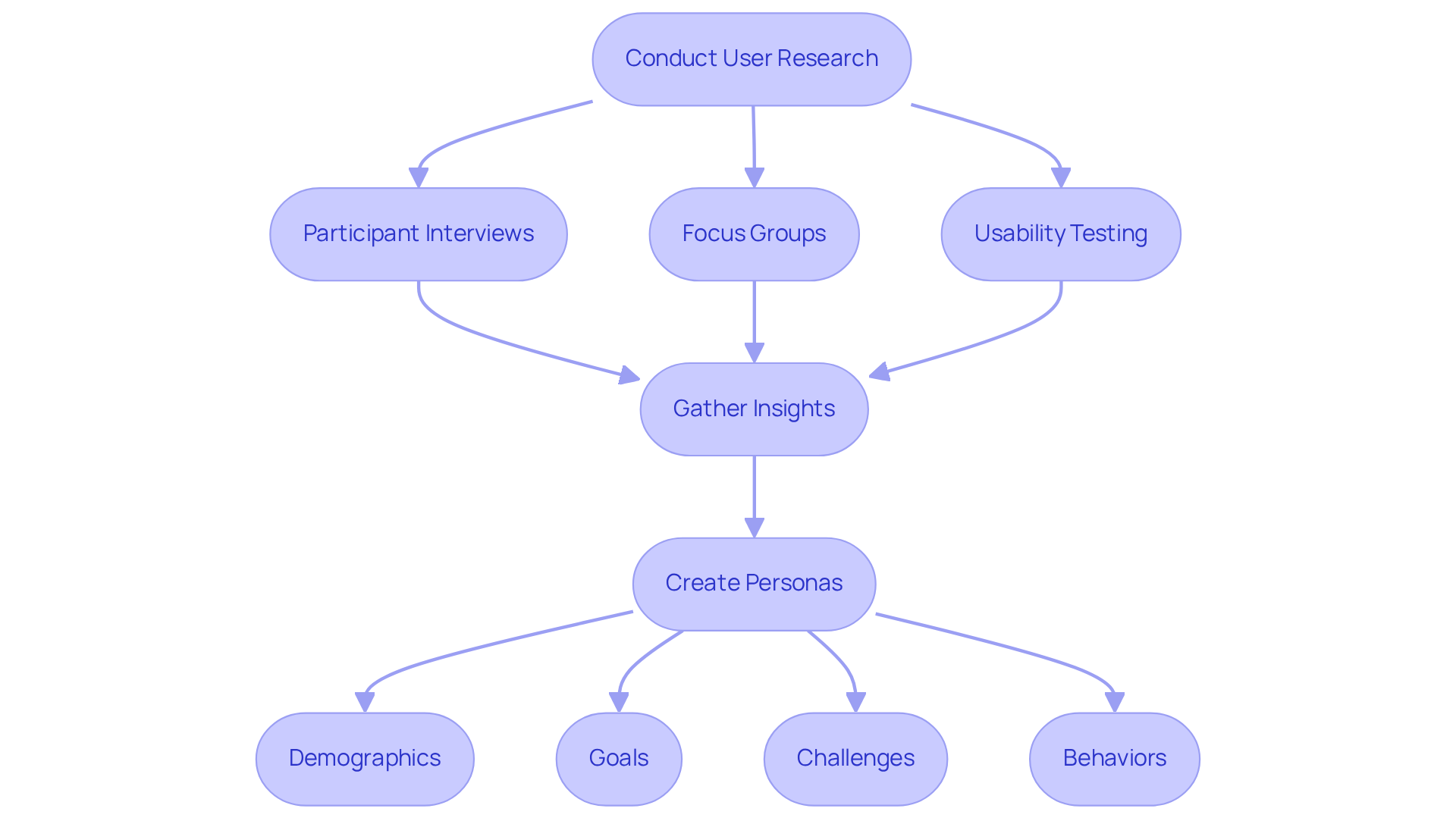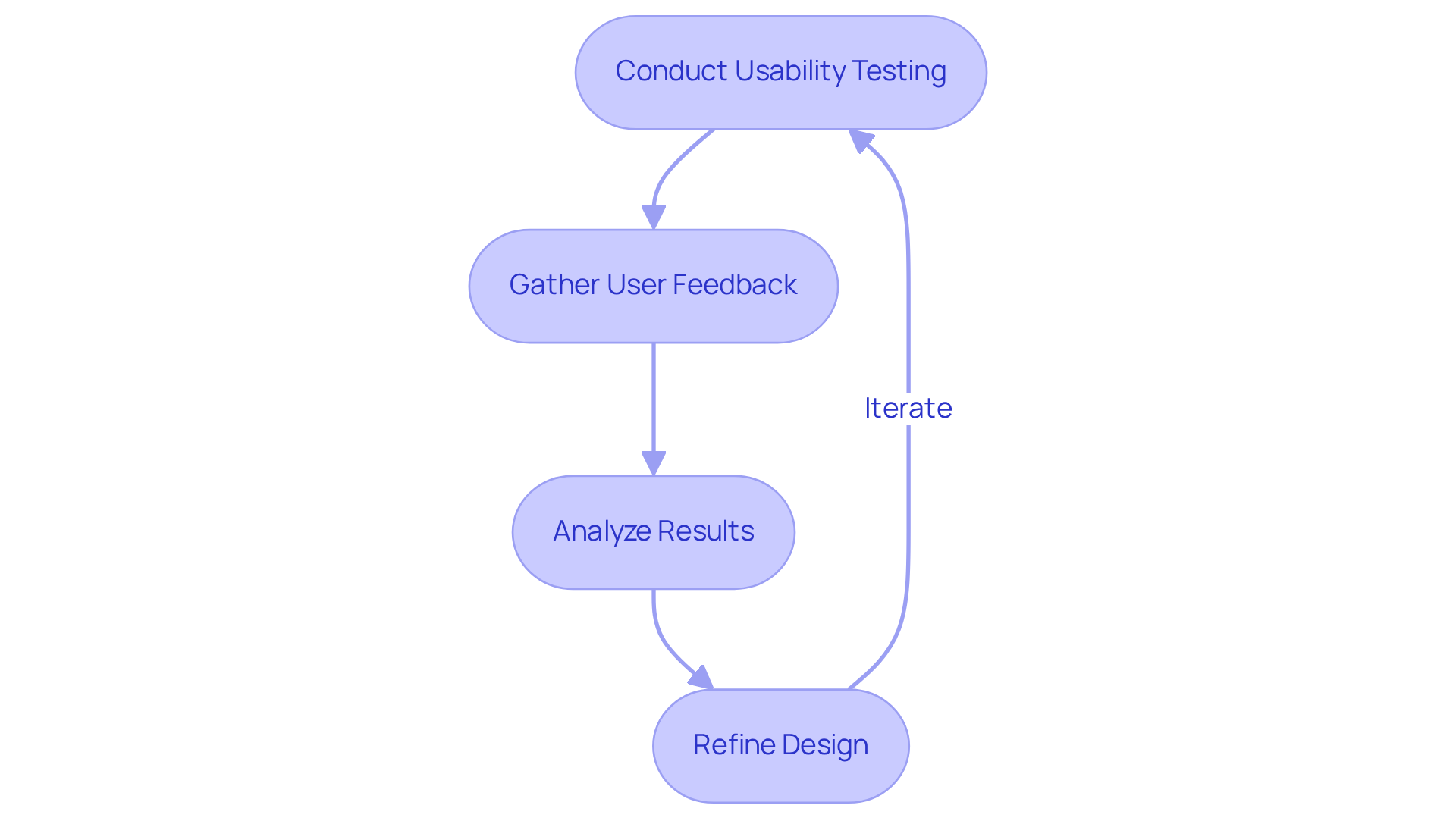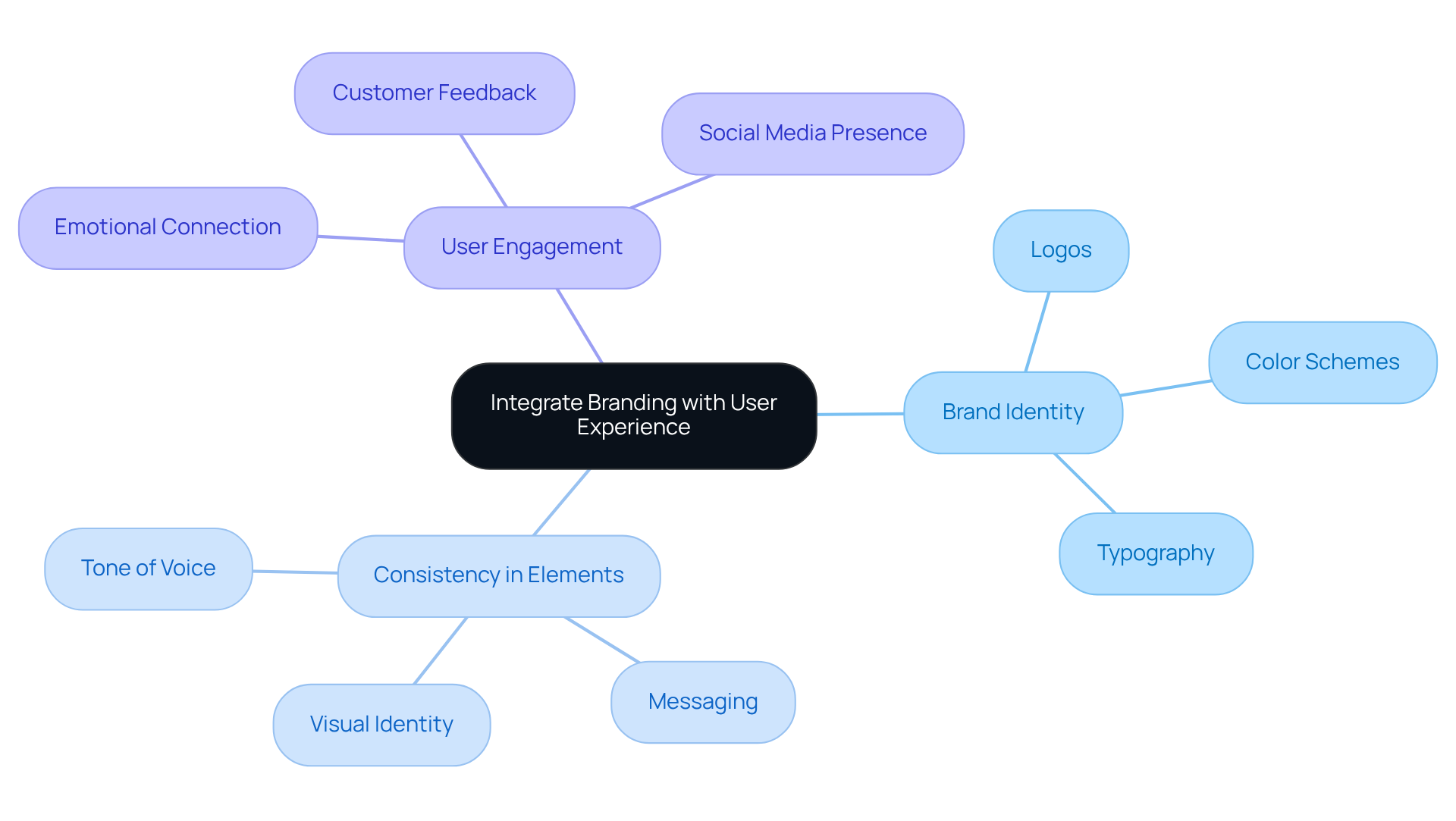Overview
For tech startups, mastering website UX design can feel overwhelming, especially when it comes to truly understanding user needs. Many founders grapple with the challenge of ensuring their platforms resonate with their audience. This struggle can lead to frustration and missed opportunities for engagement and satisfaction. However, by embracing key practices—such as:
- Conducting thorough user research
- Implementing usability testing
- Integrating consistent branding
startups can turn this challenge into a pathway for success. These strategies not only enhance user engagement but also foster a sense of loyalty among users. Successful startups have shown that targeted UX strategies can dramatically improve online performance, proving that with the right approach, it is possible to create a nurturing online environment that meets user expectations. Together, we can explore these practices and share experiences that lead to a more compassionate and effective UX design journey.
Introduction
Understanding the intricacies of user experience (UX) design can feel overwhelming for tech startups striving to find their place in a competitive digital landscape. Many founders grapple with the challenge of truly grasping user needs and behaviors, which are essential for enhancing engagement and boosting conversion rates. This struggle often leads to frustration, as the path to success seems unclear.
However, there is hope. By exploring key practices that simplify the process of mastering website UX design, startups can not only connect meaningfully with their users but also unlock their full potential. This article is here to guide you through these practices, offering insights that resonate with your journey and empower your startup to thrive.
Understand User Needs and Behaviors
To establish a successful website, tech startups must first recognize and truly understand the needs and behaviors of their clients. This can feel overwhelming, as it involves examining demographics, preferences, and the pain points that individuals face. Startups can turn to helpful tools like Google Analytics to gather valuable data on interactions and behaviors on their site. Additionally, conducting surveys and interviews can provide qualitative insights into what individuals genuinely value. By blending this information, startups can thoughtfully customize their website UX design and content features to better meet visitor expectations, ultimately leading to increased engagement and conversion rates.
In 2025, statistics suggest that effective behavior analysis can significantly enhance online performance. Well-crafted website UX design can lead to greater engagement and conversion rates. For instance:
- 88% of individuals are less likely to revisit a site after encountering poor website UX design, underscoring the importance of experience design.
- Successful examples of behavior analysis in website UX design include ArchiveSocial, which saw a remarkable 101.68% increase in clicks on their form field by optimizing their pricing page based on user feedback. This process involved analyzing interactions to pinpoint areas for improvement.
- Similarly, Majestic Wine experienced a 201% rise in inquiry form submissions after revamping their category page by minimizing distractions, enhancing messaging, and incorporating an explainer video to improve their website UX design and better address client needs.
These stories illustrate the tangible benefits of understanding client behavior, ultimately enhancing retention and satisfaction.

Conduct User Research and Create Personas
User research can often feel daunting for technology companies, especially startups eager to connect with their audience. The challenge lies in understanding who those users are and what they truly need. This is where employing techniques like participant interviews, focus groups, and usability testing becomes invaluable. These methods allow new businesses to gather essential insights about their target audience, paving the way for meaningful connections.
From this research, startups can craft personas—fictional yet realistic representations of typical individuals that embody different segments of their audience. Each persona should include key demographic details, goals, challenges, and behaviors, providing a comprehensive view of the users they aim to serve. This practice not only deepens understanding but also ensures that the design process remains centered on the individual, ultimately leading to more effective and engaging digital experiences.
By focusing on customer personas, new ventures can improve their website UX design to tailor their offerings to meet specific needs, enhancing overall satisfaction and driving success in a competitive landscape. It’s important to create a core set of 3-5 personas to keep teams from feeling overwhelmed. Establishing continuous feedback loops can further nurture innovation and adaptability in product development. Remember, you’re not alone in this journey; many founders share similar experiences, and together, we can cultivate solutions that resonate deeply with your audience.

Implement Usability Testing and Iteration
Usability testing can often feel like a daunting task for technology companies, yet it is essential for creating successful products. Many new businesses struggle to understand how users interact with their websites, resulting in missed opportunities for improvement in website UX design. By utilizing prototypes or live versions of their sites, they can observe interactions and gather invaluable insights.
Remote usability testing tools like UserTesting and Lookback offer a lifeline, allowing startups to connect with a diverse audience and gather feedback from various demographics. Research indicates that UX research can reduce project development time by as much as 50% by identifying usability issues early on, alleviating some of the stress associated with product launches.
After each testing session, it is crucial to carefully examine the results and refine the concept based on participant feedback. This iterative design process not only enhances the experience for users but also ensures that the final product meets their expectations effectively.
As Jacob Nielsen wisely noted, testing with just five participants can reveal 85% of usability issues, highlighting the effectiveness of small sample usability testing. By embracing these optimal methods, startups can significantly enhance their platform's usability with effective website UX design and foster greater customer satisfaction, creating a more positive experience for everyone involved.

Integrate Branding with User Experience
Creating an effective online platform can often feel overwhelming for startups. It's crucial to embody your brand's identity while ensuring a smooth visitor experience. Many founders struggle with this, as inconsistent branding elements—like logos, color schemes, and typography—can lead to confusion and mistrust among potential customers. This is where RNO1 shines, having collaborated with various brands to develop radical digital experiences that resonate across platforms. By showcasing consistency in branding, you can foster brand recognition and trust, which are essential for your growth.
Moreover, the tone of voice in your content should align with your brand's personality. This alignment enhances the overall experience for your audience, making them feel more connected to your mission. By integrating branding with website UX design, as exemplified by RNO1 through its transformative solutions, you can create a memorable and engaging online presence. This not only reflects your identity but also drives user engagement and loyalty.
Remember, you're not alone in this journey. Many tech startup founders face similar challenges, and it's okay to seek support. Embracing these strategies can help you cultivate a nurturing online environment that resonates with your audience and fosters lasting relationships.

Conclusion
Understanding and implementing effective website UX design poses a significant challenge for tech startups striving to succeed in a competitive landscape. Many founders feel overwhelmed by the multitude of demands, often neglecting user needs and behaviors, which can hinder their growth. By prioritizing these aspects, however, startups can create tailored experiences that engage visitors and drive conversions, ultimately alleviating some of that pressure.
The article emphasizes several key practices that can truly make a difference:
- Recognizing user needs through data analysis
- Conducting thorough user research to develop accurate personas
- Implementing iterative usability testing to refine the design
Each of these strategies plays a vital role in crafting a website that is not only functional but also enjoyable for users. The success stories of companies like ArchiveSocial and Majestic Wine stand as powerful examples of how understanding and addressing user behavior can lead to substantial improvements in engagement and conversion rates.
Ultimately, the importance of integrating branding with user experience cannot be overstated. A consistent brand identity, combined with a seamless user journey, fosters trust and encourages lasting relationships with customers. Tech startups should embrace these best practices to cultivate an online presence that genuinely reflects their mission and values, ensuring they not only meet but exceed user expectations. By prioritizing user experience, startups can embark on a path to success, creating platforms that resonate deeply with their audience and stand out in the digital landscape. Together, let’s nurture these connections and build a brighter future for your startup.
Frequently Asked Questions
Why is it important for tech startups to understand user needs and behaviors?
Understanding user needs and behaviors is crucial for tech startups as it helps them recognize demographics, preferences, and pain points, allowing for a website that better meets visitor expectations and ultimately increases engagement and conversion rates.
What tools can startups use to analyze user interactions on their website?
Startups can use tools like Google Analytics to gather valuable data on user interactions and behaviors on their site. Additionally, conducting surveys and interviews can provide qualitative insights into what individuals genuinely value.
How does effective website UX design impact user engagement?
Effective website UX design significantly enhances online performance, leading to greater engagement and conversion rates. For instance, 88% of individuals are less likely to revisit a site after encountering poor website UX design.
Can you provide examples of successful behavior analysis in website UX design?
Yes, ArchiveSocial saw a 101.68% increase in clicks on their form field by optimizing their pricing page based on user feedback. Similarly, Majestic Wine experienced a 201% rise in inquiry form submissions after revamping their category page to minimize distractions and improve messaging.
What are the benefits of understanding client behavior for startups?
Understanding client behavior enhances retention and satisfaction, leading to improved user experiences and ultimately better performance for the website.




